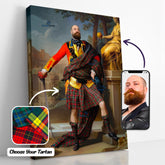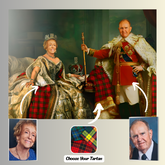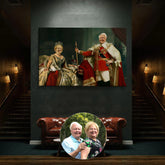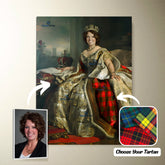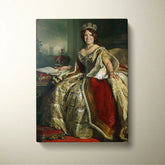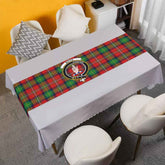-
Clan Boyd Modern Tartan Clogs Classic UH27 - Boyd Modern Tartan
Clan Boyd Modern Tartan Clogs Classic UH27 Our shoes do run a bit small. We recommend sizing up if you want to be comfortable. Size Guide Product measurements may vary by up to 3~5mm There are two different ways to wear——you can wear it...- $42.25
- $42.25
- Unit price
- per
- Boyd Modern Tartan
-
Clan Boyd Modern Tartan Christmas Tree Skirt XN41 - Boyd Modern Tartan
Clan Boyd Modern Tartan Christmas Tree Skirt XN41 Product detail: 100% polyester tricot fabric, thick and durable. Suitable for not only Christmas but also the whole winter. Velcro closure and center hole allows for easy installment and removal. One-side Printing Machine washable on cold...- From $48.25
- From $48.25
- Unit price
- per
- Boyd Modern Tartan
-
Clan Boyd Modern Tartan Halloween Pumpkin Slippers, Fluffy Spooky Slippers VM61 - Boyd Modern Tartan
Clan Boyd Modern Tartan Halloween Pumpkin Slippers, Fluffy Spooky Slippers VM61 Product Informations: Material: 100% polyester outer-layer and lining, rubber soles. These personalized slippers are a home staple that now becomes even more stylish with your custom touch. Each slipper is made 100% with...- $38.45
- $38.45
- Unit price
- per
- Boyd Modern Tartan
-
Clan Boyd Modern Tartan Crest Christmas Santa Hat ED21 - Boyd Modern Tartan
Clan Boyd Modern Tartan Crest Christmas Santa Hat ED21 Product Detail: Material: Polyester Design Area: Single side full width printing Sizes:'S (26 x 38 cm); L (32.5 x 45 cm)- From $25.41
- From $25.41
- Unit price
- per
- Boyd Modern Tartan
-
Clan Boyd Modern Tartan Crest Christmas Stocking ZU97 - Boyd Modern Tartan
Clan Boyd Modern Tartan Crest Christmas Stocking ZU97 DESCRIPTION: Christmas Stocking is used to display as home decoration or meaningful gifts for friends and relatives on special occasions such as Christmas, Valentine, birthday' Dimensions: (Cuff Width x Length x Width): 20 x 40 x...- $24.45
- $24.45
- Unit price
- per
- Boyd Modern Tartan
-
Clan Boyd Modern Tartan Christmas Ceramic Ornament Highland Cows Style TH52 - Boyd Modern Tartan
Clan Boyd Modern Tartan Christmas Ceramic Ornament Highland Cows Style TH52 Product Detail:One of the best things about Christmas is that it gives you an excuse to dress up your home with all of the lovely ornaments we associate with the holiday season. With...- From $14.45
- From $14.45
- Unit price
- per
- Boyd Modern Tartan
-
Clan Boyd Modern Tartan Bomber Jacket PY44 - Boyd Modern Tartan
Boyd Modern Tartan Clan Bomber Jacket PY44 Details: Our Bomber Jackets are made of 95% polyester and 5% spandex, and they keep you comfortable, cool, and dry while you work and play. Bomber Jackets with high-tech graphic prints, vibrant designs, and colors look modern...- $62.45
- $62.45
- Unit price
- per
- Boyd Modern Tartan
-
Clan Boyd Tartan Crest Table Runner Cotton BX71 - Boyd Tartan
Clan Boyd Tartan Crest Table Runner Cotton BX71 Product detail: Made of durable cotton linen cloth material. Lightweight, durable and could be folded away compactly. Multi-function, stylish decor to any room or table. Gentle hand wash separately in cold water; no shrinkle; no color...- $41.15
- $41.15
- Unit price
- per
- Boyd Tartan
-
Clan Boyd Modern Tartan Table Runner Cotton CA66 - Boyd Modern Tartan
Clan Boyd Modern Tartan Table Runner Cotton CA66 Product detail: Made of durable cotton linen cloth material. Lightweight, durable and could be folded away compactly. Multi-function, stylish decor to any room or table. Gentle hand wash separately in cold water; no shrinkle; no color...- $41.15
- $41.15
- Unit price
- per
- Boyd Modern Tartan
-
Clan Boyd Modern Tartan Christmas Ugly Sweater GM76 - Boyd Modern Tartan
Boyd Modern Tartan Clan Christmas Ugly Sweater GM76 Product Detail: Each sweater is constructed from a premium woven polyester that is ultra-soft and incredibly comfortable. Features a specialty high definition heat-dye application that ensures long lasting color vibrancy even after machine washing. Fabric is...- $48.45
- $48.45
- Unit price
- per
- Boyd Modern Tartan
-
Clan Boyd Modern Tartan Scottish Lion Hawaiian Shirt DM97 - Boyd Modern Tartan
Boyd Modern Tartan Clan Scottish Lion Hawaiian Shirt DM97 These Hawaiian shirts and shorts are suitable for hot summer days or beach trips with your friends, family, and loved ones. This is an excellent gift, vacation outfit, or simply revamp your summer wardrobe.- Material:...- $43.25
- $43.25
- Unit price
- per
- Boyd Modern Tartan
-
Clan Clan Boyd Modern Tartan Leather Bag LA15 - Boyd Modern Tartan Clan
Boyd Modern Tartan Clan Leather Bag LA15 Product Details: PU leather material is luxurious - genuine - smooth Size 29cm x 20cm x 10.5cm helps girls to hold the whole world Above all, this is an indispensable fashion item with cool and personality The...- $62.45
- $62.45
- Unit price
- per
- Boyd Modern Tartan Clan
-
Clan Boyd Modern Tartan Saddle Handbags QD86 - Boyd Modern Tartan Clan
Boyd Modern Tartan Clan Saddle Handbags QD86 Product Detail: Manufactured with premium water-proof canvas material. Features a comfortable and sturdy adjustable cross-body carrying strap made with leather and high-quality stitching for long-lasting durability. Finished with multiple interior compartments to keep your items organized.- $55.15
- $55.15
- Unit price
- per
- Boyd Modern Tartan Clan
-
Clan Boyd Modern Tartan Hawaii Dress HV98 - Boyd Modern Tartan
Boyd Modern Tartan Clan Hawaii Dress HV98 Product detail: All of our Midi Dresses are custom-made-to-order and handcrafted to the highest quality standards. Made of polyester/spandex material for a perfect fit. Anti-Static, Anti-wrinkle, Breathable, Lightweight ideal for Spring and Summer fun. Each Dress is...- $54.25
- $54.25
- Unit price
- per
- Boyd Modern Tartan
-
Clan Boyd Modern Tartan Crest Jogger Sweatpants LL88 - Boyd Modern Tartan
Boyd Modern Tartan Clan Crest Jogger Sweatpants LL88 Product details: This unisex jogger features a soft and durable fabric. These garments are made from polyester, with each design being made-to-order 95% polyester, 5% spandex Double layer side insert pockets High definition printing colours Design...- $48.25
- $48.25
- Unit price
- per
- Boyd Modern Tartan
-
Clan Boyd Modern Tartan Bow Tie XI68 - Boyd Modern Tartan Clan
Boyd Modern Tartan Clan Bow Tie XI68 Product detail: Unique item with your custom design can be worn on various occasions, such as weddings,'anniversaries, and birthday parties. 100% polyester satin, silky and durable. Adjustable neckband fits neck sizes 11.5' to 20' Flat measurement without...- $34.45
- $34.45
- Unit price
- per
- Boyd Modern Tartan Clan
-
Clan Boyd Tartan Crest Keychain QI93 - Boyd Tartan Clan
Boyd Tartan Clan Crest Keychain QI93 Product detail: This personalized keychain for pictures are the perfect choice for a fun gift idea, the choice is yours to come up with a surprise for someone you love. The keychain is made of PMMA, environmentally, friendly,...- From $15.25
- From $15.25
- Unit price
- per
- Boyd Tartan Clan
-
Clan Boyd Tartan Unisex Baseball Jersey ML93YP68 - Boyd Tartan
Boyd Tartan Clan Unisex Baseball Jersey ML93YP68 Product Detail: Each of our baseball jerseys is custom-made-to-order and handcrafted to the highest quality standards. It is not only extremely soft to the touch but breathable as well. Our jersey is printed on sustainable fabrics so...- $42.25
- $42.25
- Unit price
- per
- Boyd Tartan
-
Clan Boyd Modern Tartan Crest Tumbler TA88 - Boyd Modern Tartan Clan
Boyd Modern Tartan Clan Crest Tumbler TA88 Product Detail: Boyd Modern Tartan Crest Tumbler Introducing our Tartan Tumbler, a perfect companion for your daily hydration needs. This mobile tumbler comes with a slide lid and an ideal size, providing convenience as you enjoy your...- From $45.99
- From $45.99
- Unit price
- per
- Boyd Modern Tartan Clan
-
Clan Blanket Boyd Tartan Crest Blanket To My Wife Style , Gift From Scottish Husband WH40 - Scots Print Blanket - Boyd Tartan Clan Crest Blanket To My Wife Style Gift From Scottish Husband
Scots Print Blanket Boyd Tartan Clan Crest Blanket To My Wife Style , Gift From Scottish HusbandWH40 Product detail: Each blanket features a premium suede polyester print for beautiful color vibrancy. Cozy underside is constructed from an ultra-soft micro fleece fabric to keep you...- $65.02
- $65.02
- Unit price
- per
- Scots Print Blanket - Boyd Tartan Clan Crest Blanket To My Wife Style Gift From Scottish Husband
Ex: Your Tartan + Product
Popular Products
Turn Me Royal Personalized Portrait from Your Photo, Custom Tartan. Custom Canvas Wall Art as Gift for Men
- From $32.45
- From $32.45
- Unit price
- / per
Royalty Couple Personalized Portrait from Your Photo, Custom Tartan. Custom Canvas Wall Art
- From $47.45
- From $47.45
- Unit price
- / per
The Queen Personalized Portrait from Your Photo, Custom Tartan. Custom Canvas Wall Art as Gift for Women
- From $32.45
- From $32.45
- Unit price
- / per
List Of Tartan
-
Clan A
- Abercrombie Tartan
- Aberdeen Tartan
- Abernethy Tartan
- Adair Tartan
- Adam Tartan
- Ayrshire Tartan
- Agnew Tartan
- Aikenhead Tartan
- Ainslie Tartan
- Aiton Tartan
- Allan Tartan
- Alexander Tartan
- Allardice Tartan
- Allison Tartan
- Anderson Tartan
- Angus Tartan
- Anstruther Tartan
- Arbuthnot Tartan
- Armstrong Tartan
- Arnott Tartan
- Auchinleck Tartan
- Ayrshire Tartan
-
Clan B
- Baillie Tartan
- Bain Tartan
- Baird Tartan
- Balfour Tartan
- Bannatyne Tartan
- Bannerman Tartan
- Barclay Tartan
- Baxter Tartan
- Beaton Tartan
- Bell Tartan
- Belshes Tartan
- Bethune Tartan
- Beveridge Tartan
- Binning Tartan
- Bisset Tartan
- Blackadder Tartan
- Blackstock Tartan
- Black Watch Tartan
- Blair Tartan
- Blane Tartan
- Blyth Tartan
- Borthwick Tartan
- Boswell Tartan
- Bowie Tartan
- Boyd Tartan
- Boyle Tartan
- Brisbane Tartan
- Brodie Tartan
- Brown/ Broun Tartan
- Bruce Tartan
- Buccleuch Tartan
- Buchan Tartan
- Buchanan Tartan
- Burnett Tartan
- Burns Tartan
- Butter Tartan
- Byres Tartan
-
Clan C
- Cairns Tartan
- Calder Tartan
- Callander Tartan
- Cameron Tartan
- Campbell Tartan
- Campbell of Breadalbane Tartan
- Campbell of Cawdor Tartan
- Carmichael Tartan
- Carnegie Tartan
- Carruthers Tartan
- Cathcart Tartan
- Chalmers Tartan
- Charteris Tartan
- Chattan Tartan
- Cheyne Tartan
- Chisholm Tartan
- Christie Tartan
- Clark Tartan
- Clelland Tartan
- Clephan Tartan
- Clergy Tartan
- Cochrane Tartan
- Cockburn Tartan
- Colquhoun Tartan
- Colville Tartan
- Cooper Tartan
- Couper Tartan
- Craig Tartan
- Cranstoun Tartan
- Crawford Tartan
- Crichton Tartan
- Crief District Tartan
- Crosbie Tartan
- Cumming Tartan
- Cunningham Tartan
- Currie Tartan
- Clan D
- Clan E
- Clan F
- Clan G
- Clan H
- Clan I
- Clan J
- Clan K
- Clan L
-
Clan M
- Maitland Tartan
- Malcolm Tartan
- Mar Tartan
- Marjoribanks Tartan
- Maxtone Tartan
- Matheson Tartan
- Maule Tartan
- Maxwell Tartan
- Meldrum Tartan
- Melville Tartan
- Menzies Tartan
- Mercer Tartan
- Middleton Tartan
- Moffat Tartan
- Moncrieffe Tartan
- Montgomery Tartan
- Monypenny Tartan
- Moncreiffe Tartan
- Monteith Tartan
- Morrison Tartan
- Mouat Tartan
- Moubray Tartan
- Mow Tartan
- Muir_More Tartan
- Muirhead Tartan
- Munro Tartan
- Murray Tartan
- Murray of Atholl Tartan
-
Clan Mc/Mac
- MacAlister Tartan
- MacArthur Tartan
- MacAlpine Tartan
- MacAulay Tartan
- MacBain Tartan
- MacBean Tartan
- MacBeth Tartan
- MacCallum Tartan
- MacCraig Tartan
- MacColl Tartan
- MacCorquodale Tartan
- MacDiarmid Tartan
- MacDonald Tartan
- MacDonald of Clanranald Tartan
- MacDonald of Sleat Tartan
- MacDonnell of Glengarry Tartan
- MacDonnell of Keppoch Tartan
- MacDougall Tartan
- MacDowall Tartan
- MacDuff Tartan
- MacEwen_MacEwan Tartan
- MacEdward Tartan
- MacFarlane Tartan
- MacGill Tartan
- MacGillivray Tartan
- MacGregor Tartan
- MacGowan (McGowan) Tartan
- MacHardy Tartan
- MacIan Tartan
- MacInnes Tartan
- MacIntyre Tartan
- MacKay Tartan
- MacKillop Tartan
- MacKellar Tartan
- Mackinlay Tartan
- MacKenzie Tartan
- Mackie Tartan
- MacKinnon Tartan
- MacKintosh / MacIntosh Tartan
- MacLeod Tartan
- MacMillan Tartan
- MacNab Tartan
- MacNaughton Tartan
- MacNeil / MacNeill Tartan
- MacNeil of Colonsay Tartan
- MacNicol Tartan
- MacPhail Tartan
- MacPhee_MacFie Tartan
- MacPherson Tartan
- MacQuarrie Tartan
- MacQueen Tartan
- MacRae Tartan
- MacRow Tartan
- MacSporran Tartan
- MacTaggart Tartan
- MacTavish Tartan
- MacThomas Tartan
- McCorquodale Tartan
- McCulloch Tartan
- McFadzen Tartan
- McGeachie Tartan
- McIver Tartan
- McKerrell Tartan
- Clan N
- Clan O
- Clan P
- Clan R
-
Clan S
- Sandilands Tartan
- Scott Tartan
- Scrymgeour Tartan
- Selkirk Tartan
- Sempill Tartan
- Seton Tartan
- Shaw Tartan
- Shepherd Tartan
- Sinclair Tartan
- Skene Tartan
- Skirving Tartan
- Smith Tartan
- Somerville Tartan
- Spalding Tartan
- Spens Tartan
- Spottiswood Tartan
- Stevenson Tartan
- Stewart Tartan
- Stewart of Appin Tartan
- Stirling Tartan
- Strachan Tartan
- Straiton Tartan
- Strange Tartan
- Strathclyde District Tartan
- Stuart of Bute Tartan
- Sutherland Tartan
- Swinton Tartan
- Clan T
- Clan U W Y
- Request Your Clan
Clan Boyd (Boyd Tartan)
1. About Clan Boyd (Boyd Tartan)
2. Clan Boyd History (Boyd Tartan)
The name's origin could be geographical or descriptive, but it is unmistakably Gaelic. The word Buidhe, which means "fair" or "yellow," may have originated as a descriptive adjective.
The word "Bod"—whose genitive case is "Boid"—may also refer to Bute, the island that is closest in size to Arran and is known as "Bod" in Gaelic.
A contract between the Lord of Eglinton and the burgh of Irvine was witnessed by Dominus Robertus de Boyd in 1205; as a result, the name was used in south-west Scotland throughout the 13th century.
Duncan Boyd died at the hands of the English in 1306 after professing loyalty to Robert the Bruce and the cause of Scottish independence.
Sir Robert Boyd shared the same fervor for the Bruce cause and served as a commander in the Battle of Bannockburn in 1314.
For his valiant actions there, he was awarded lands in Kilmarnock, Bondington, and other parts of Ayrshire that had been taken from the Balliols.
James II gave the Boyd family the honorific title "Lord Boyd of Kilmarnock," which also served as a proof that they had acquired peerage.
The coup d'état Robert, the oldest son of Sir Thomas Boyd of Kilmarnock, was going to try was made possible by this platform.
He served as one of James III's Regents after the young King's father passed away in 1460 since he was a dependable royal officer.
Robert Boyd had a significant impact on the young James through his younger brother Thomas. So much so that by 1466, Robert Boyd was the Great Chamberlain and Thomas Boyd served as the King's instructor for knightly exercises.
The coup consisted of kidnapping his young subject and persuading Parliament to pass an Act, with the royal nod of course (though it is questionable whether this was willingly granted), designating him as the only ruler of the realm.
When Thomas married Princess Mary, the King's sister, and gave her the title "Earl of Arran and Kilmarnock," their position was strengthened.
The newly constituted Earl of Arran, Robert Boyd, and his brother Alexander Boyd, however, suffered as a result of their pursuit of privilege.
Due to their success, a plot to undermine them was hatched in order to convince the King that the Boyd ambition was endangering the kingdom itself.
The three were called to appear before the King and Parliament in Edinburgh to respond to these allegations. Of the three, only Sir Alexander—a ill man—met the fate that they were fully aware would befall him—execution for treason.
When the Earl of Arran, Thomas Boyd, learned of Lord Boyd's escape to England, he decided that his exile in Europe would be permanent.
Under the guise of forgiving her husband Thomas, Princess Mary was called back from Scotland. Being jailed by her brother, her marriage was dissolved because Thomas's presence did not convince him to end his exile and risk death.
The family supported the King's cause throughout the Civil War, and William, Lord Boyd, was rewarded by being made Earl of Kilmarnock after the Restoration.
During the rebellion of 1715, the third earl led a regiment of Ayrshire volunteers and resisted the Stewart claim.
The fourth earl abandoned his father's sympathies and supported Prince Charles Edward Stewart, the Young Pretender, who named him a general-level member of the Privy Council.
He participated in the Battle of Culloden, but on August 18, 1746, he was arrested and executed on Tower Hill.
3. Clan Boyd Tartans
The Boyd tartan was created in 1948 for the Earl of Kilmarnock and registered with the office of Lord Lyons in 1957.
The Hay-Leith tartan and the hunting Stewart have both influenced the Earls of Kilmarnock, who are descended from both the Hays and the Stewarts.
Modern describes the dye colors, which are typically dark.
Y/10 G44 K4 B4 K4 B4 K20 R78 G10 R8 K8 W/10 Threadcount
Boyd Modern
Boyd Ancient
4. Clan Boyd Crest & Coats of Arms
4.1 Clan Boyd Crest
Worn by all of the name and ancestry
4.2 Clan Boyd Coat of Arms
Note on Coats of Arms: A coat of arms is given to an individual under Scottish heraldic law (with the exception of civic or corporate arms). A 'family coat of arms' does not exist.
With the exclusions listed above, the weapons depicted below are personal weapons. The only person authorized to use these weapons is the grantee.
Boyds of Ballymacool
Arms of (the late) Dr. Frederick Tilghman Boyd
5. Clan Boyd Places & People
5.1 Clan Boyd Places
5.1.1 Dean Castle
Dean Castle is located near Kilmarnock, East Ayrshire, Scotland, within the Dean Castle Country Park. Around 1350, Sir Thomas Boyd constructed it as the Boyd clan's fortress.
The castle was still owned by the Boyd family until James Boyd sold it in 1746.
5.1.2 Portencross Castle
King Bruce rewarded Robert Boyd for his dedication by giving him Portencross Castle and other important lands in Strathclyde.
Over four hundred years, from roughly 1385 to 1785, the Boyd family owned Portencross.
5.1.3 Law Castle
When Princess Mary, the daughter of James II, wed Thomas, Master of Boyd and later Earl of Arran, Law Castle was constructed in 1468. The Tower of Kilbride is another name for the castle.
5.1.4 Penkill Castle
When it was sold in the 1960s, the castle was last owned by the Boyd family.
5.2 Clan Boyd People
5.2.1 William Boyd (1704 – 1746)
William Boyd, the fourth Earl of Kilmarnock, attended Glasgow University.
William initially sided with the government in the uprising of 1715, but in the rebellion of 1745, either because of a personal slight, the sway of his wife, or his precarious situation, he deserted George II and joined Charles Edward Stuart, the Young Pretender.
He was named a colonel of guards before being made a privy counsellor to Charles. He participated in the battles of Falkirk and Culloden, when he was captured. On August 18, 1746, he was decapitated on Tower Hill.
5.2.2 Sir John Boyd Orr, 1st Baron Boyd-Orr (1880 – 1971)
A Scottish physician, biologist, and politician who worked with the UN Food and Agriculture Organization and conducted scientific study on nutrition was awarded the Nobel Peace Prize.
Orr was raised in Kilmaurs, a small town in East Ayrshire, Scotland. He later attended a teachers' college and the University of Glasgow to pursue his studies in the arts while preparing to become a teacher.
He returned to the university to finish his studies in biology and medicine after three years of teaching. He worked as a military physician for the British Army and Royal Navy during World War I, first on active service and then as a researcher on military diets.
His study after the war was primarily focused on animal nutrition, but as a researcher and an outspoken advocate for changing people's diets, his attention shifted to human nutrition.
Boyd Orr held a number of positions after the Second World War, most notably at the FAO, where his extensive proposals for enhancing food production and its fair distribution fell short of receiving the support of Britain and the US.
Following his resignation from the FAO, he took on a number of directorships, demonstrated his skill as a stock market investor, and amassed a sizeable personal fortune.
As a result, when he was awarded the Nobel Prize in 1949, he was able to donate the entire sum to organizations working to bring about world peace and a unified global government. In 1949, he was made a peer and given the title Baron Boyd-Orr.
John Boyd Orr is honored at the University of Glasgow with a building bearing his name, and the Hunterian Museum houses his Nobel Prize.
5.2.3 Billy Boyd (born 1968 in Glasgow)
The Scottish actor is most known for his roles as Barrett Bonden in Peter Weir's Master and Commander: The Far Side of the World and Peregrin Took (Pippin) in the Lord of the Rings film adaptations.
- Choosing a selection results in a full page refresh.

